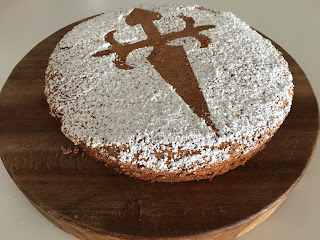Tarta de Santiago
A surprisingly easy and delicious traditional Spanish "cake" that I came across when I was looking for a 'different' dessert recipe. Torta de Santiago in Gallego or Tarta de Santiago Castiliano, literally means St. James's cake, an almond cake or pie from Galicia in northern Spain, its origins are in the Middle Ages. It has many resemblances to a Bakewell Tart, in fact some recipes include a pastry or puff pastry base. My suggestion here is the plain version, with no pastry!
Santiago, is a Spanish way to say St James. He also happens to be the Patron Saint of Spain and of the northern Province of Galicia, from where this recipe originates.
Ingredients
250 gm granulated sugar
250 gm ground almonds
5 x large'ish eggs, organic and free range if possible
1 x tablespoonful almond essence
1 x level teaspoonful powdered cinnamon
1 x lemon (zest only)
Icing sugar - for decoration
Butter - for greasing
Plain flour - for dusting
Method
Butter a 20/22 cm spring sided baking tin lightly, dust generously with flour and line the base with baking parchment.
Pre-heat the oven to 175 C
Put the ground almonds into a large mixing bowl (I'm lucky, I have a food mixer) together with the sugar, lemon zest and cinnamon; combine them well and finally add the eggs, beaten if you're not using a mixer or just spank them lightly if you don't like violence!. Stir the ingredients together then add the almond essence to the mix. Some people also add just a little brandy or sweet liqueur to the mix; if you do though don't overdo it, about a tablespoonful is enough.
At this point the mixture will be very loose, that's OK, its the way its meant to be. Next gently pour the mixture into the baking tin and put the tin on a middle shelf of the oven and cook for 30 - 40 minutes until a skewer comes out clean when inserted into the cake. Depending on your oven, it might be a good idea to cover the baking tin with foil for the last ten minutes of cooking time, just to stop the top from burning, remember there's an awful lot of sugar in the mix!
When the cake is cooked, remove the tin from the oven and allow the cake to cool for ten minutes or so, on a wire rack before removing it from the tin. Even if you have used a spring sided baking tin, taking the cake from the tin can be quite tricky as the top becomes "crispy" as it cooks, so first check that it is loose in the tin, if not gently ease the sides with a sharp knife, open the spring clip and "Voila!", a lovely moist tart; allow the tart to cool for about another thirty minutes before removing the base and setting it on a wire rack to cool completely. For cooks unable to use a spring sided tin, ease the sides of the tart around the edges of the tin and put a clean tea towel over it, then holding the cloth tight, invert the tin and shake it gently - the cake should now be resting in the tea towel. Put the wire rack back on top of the inverted cake and gently turn it "right side up!" See, I told you it was tricky!
Finally when the cake has cooled, it is traditional to add a simple decoration by cutting out a "St James's cross" in the form of a silhouette*, putting it on the top of the cake and then lightly dusting the cake top with icing sugar. Gently lift the stencil to reveal the shape of the cross on the cake top.
Finally to serve this very rich and moist cake, cut it into either eight or twelve wedge shaped slices and present it with a generous helping of slightly sweetened vanilla flavoured whipped cream.
* You can find the stencil for a cross of St James on the internet. Just Google it!


